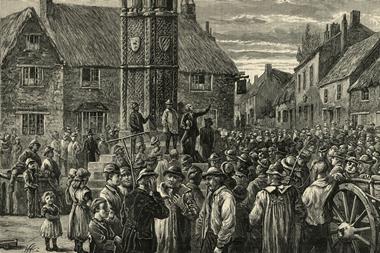Readers discuss DDT, reveal new information about Humphry Davy and ponder how to deal with errors
DDT history
The feature on DDT brought back memories. I have to hand a blurred photograph of myself at the laboratory bench, testing DDT.
I joined the Geigy Colour Company in Manchester in 1948 as a laboratory assistant. During the war, the resident Swiss MD was proud to receive a letter from Winston Churchill, praising the contribution of the factory to the war effort.
As Mike Sutton outlines, by 1950 it was necessary to cease DDT manufacture. We had to find an alternative use for the DDT production unit, equipment and employees. With the base chemical phenol already available on site, the choice fell to manufacture of N-acetyl-p-aminophenol, paracetamol. Considerable improvisation was necessary, and in the later stages of the first batch, debris from DDT wooden press plates was found floating in the paracetamol solution as it rested in a box filter.
The plant chemist went to nearby Woolworths and bought a pair of wellington boots and some children’s fishing nets. Donning the wellies, he spent the afternoon in the box filter and its contents, fishing out the floaters.
We joked that the first batch would not only cure your headache but get rid of anything that might be lurking in your hair.
Walter Cuthbert FRSC CChem
Knutsford, UK
Mike Sutton’s article on the history of DDT delighted me. I entered the world of organochlorine insecticides when I joined Shell Research in 1964. I was soon analysing environmental samples for the whole spectrum of chlorinated insecticides, using gas liquid chromatography (GLC) with the superbly sensitive electron capture detector.
It was rare to find DDT residues in appreciable quantities. What was found was DDE, the ethene derivative resulting from the dehydrochlorination of DDT, and DDD, formed by mono- substituting one chlorine for hydrogen in the trichloromethane group of DDT. DDE was the primary bioaccumilant. Because its GLC profile using methyl silicone stationary phases was almost identical to that of dieldrin, multiple analyses on polar and non-polar stationary phases were needed to achieve the correct insecticide residue profile. It was DDE which had the effect of thinning egg shells, which contributed to the decline of raptor numbers. The structural similarity of DDE to stilbestrol, the banned synthetic hormone, is suggestive of the mode of action.
It is not uncommon to come across DDT formulations in antiques fairs. I have 10% DDT military louse powder, DDT furniture polish and an assortment of domestic spray refills. I have given a talk ‘A nostalgic stroll through pest control’, and my exhibits will interest a museum when I am gone.
It is easy to look back with scorn on the companies who made and marketed the organochlorine insecticides, but they employed staff who were honest and professional, and who believed that their company’s products were for the benefit of mankind. Rachel Carson’s Silent Spring reached the hearts of many readers, but the issues are complex and the true balance of good and evil associated with organochlorine insecticides is difficult to determine.
Michael Baldwin FRSC
Via email
Answers and ancestry
The illegible word in Humphry Davy’s notebook, referring to Davy and Newton, must surely be ‘phosphine’ (see the third image in the report on the Davy Notebooks Project).
Impure phosphine has been described as smelling of rotten fish, so it seems that Davy was being sarcastic when he called it ‘most delightful’.
Robert Haresnape
Via email
Almost 20 years ago Sherlock Holmes was admitted to an extraordinary honorary fellowship of the Royal Society of Chemistry. In my own book The Sherlock Holmes Stories and Combustion Science, I comment on the statement made by Holmes in The Adventure of the Greek Interpreter that ‘Art in the blood is liable to take the strangest forms.’ He is referring to a well-known artist amongst his forebears, and is making the point that a very gifted family will, over the generations, distinguish itself in different ways. As an example, I mention in the book that the physicist Max Born was the grandfather of the singer Olivia Newton-John. I could have also mentioned the musician Ralph Vaughan Williams: Charles Darwin was his great-uncle. Many more examples could be given.
I thought of all of this when reading the article about Humphry Davy. A notable descendant of Davy was John Davy Hayward, whose entry in Oxford Dictionary of National Biography makes interesting reading. Davy Hayward was a bibliographer of note, and published compilations of works by authors including John Donne and Jonathan Swift. He is perhaps best known for his association with T S Eliot, with whom he shared a flat in London for 10 years and some of whose works he edited. Correspondence between Eliot and Davy Hayward was gifted to King’s College Cambridge, and literary researchers can apply for access to it.
Clifford Jones FRSC
University of Chester, UK
Critical errors
Valentin Rodionov’s article relates to the publication of questionable claims for a graphyne analogue. It is true that sites such as PubPeer provide an avenue for criticism of published anomalies. But PubPeer can also propagate misleading information.
It appears that some journals are dependent on publishing fees for their survival and may be reluctant to be overly critical of a dependable source of revenue.
The field of photodynamic therapy, where malignant cells are selectively sensitised to light and then irradiated, is also not free from published errors that have somehow eluded peer review. I have provided a series of comments on such incidents (for an example, see DOI: 10.1111/php.13899).
One approach to ensuring that the literature is free from error is used by the publication Organic Synthesis, where the ‘checkers’ carry out the steps involved in each synthetic procedure and report on the reliability of the data. This is clearly not feasible for biological or clinical studies. Any irreproducible claims can be contradicted by future publications by other groups, but this does represent a substantial waste of effort. The remedy for this situation is not obvious.
Many journals appear reluctant to be overly critical of incoming reports. I am periodically reprimanded by editors for being overly critical of submissions.
D H Kessel FRSC
Detroit, US
Chemistry World welcomes letters, which should be concise (normally fewer than 300 words) and timely. Those selected for publication are subject to editing for clarity and length. Letters should be marked ‘for publication’ and sent to chemistryworld@rsc.org
We do not routinely acknowledge letters.












No comments yet